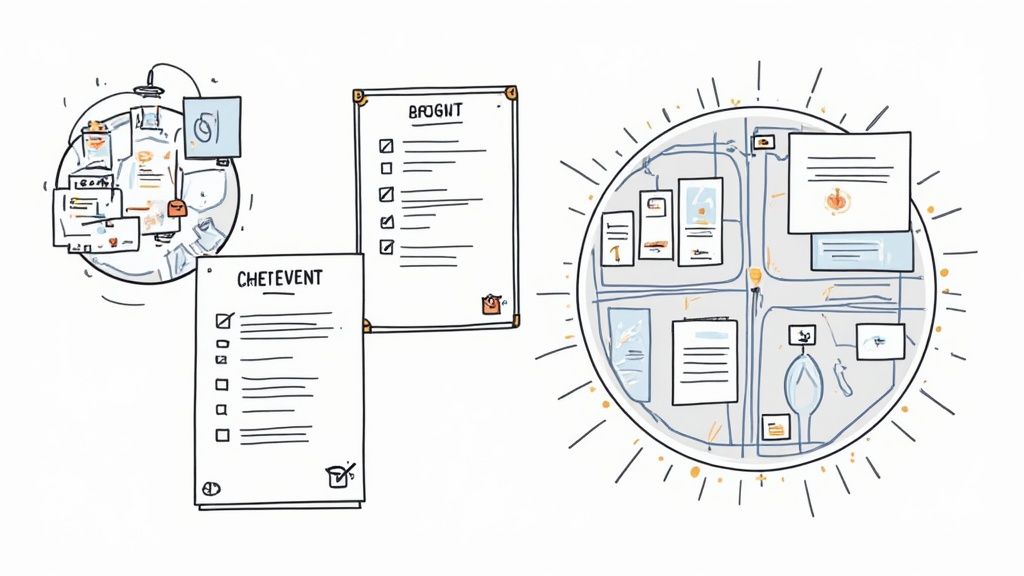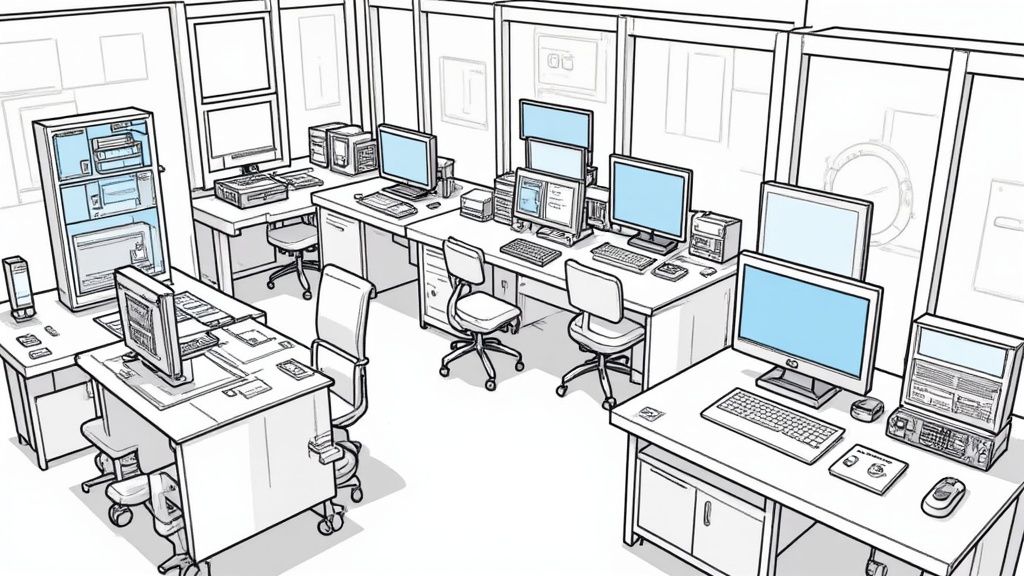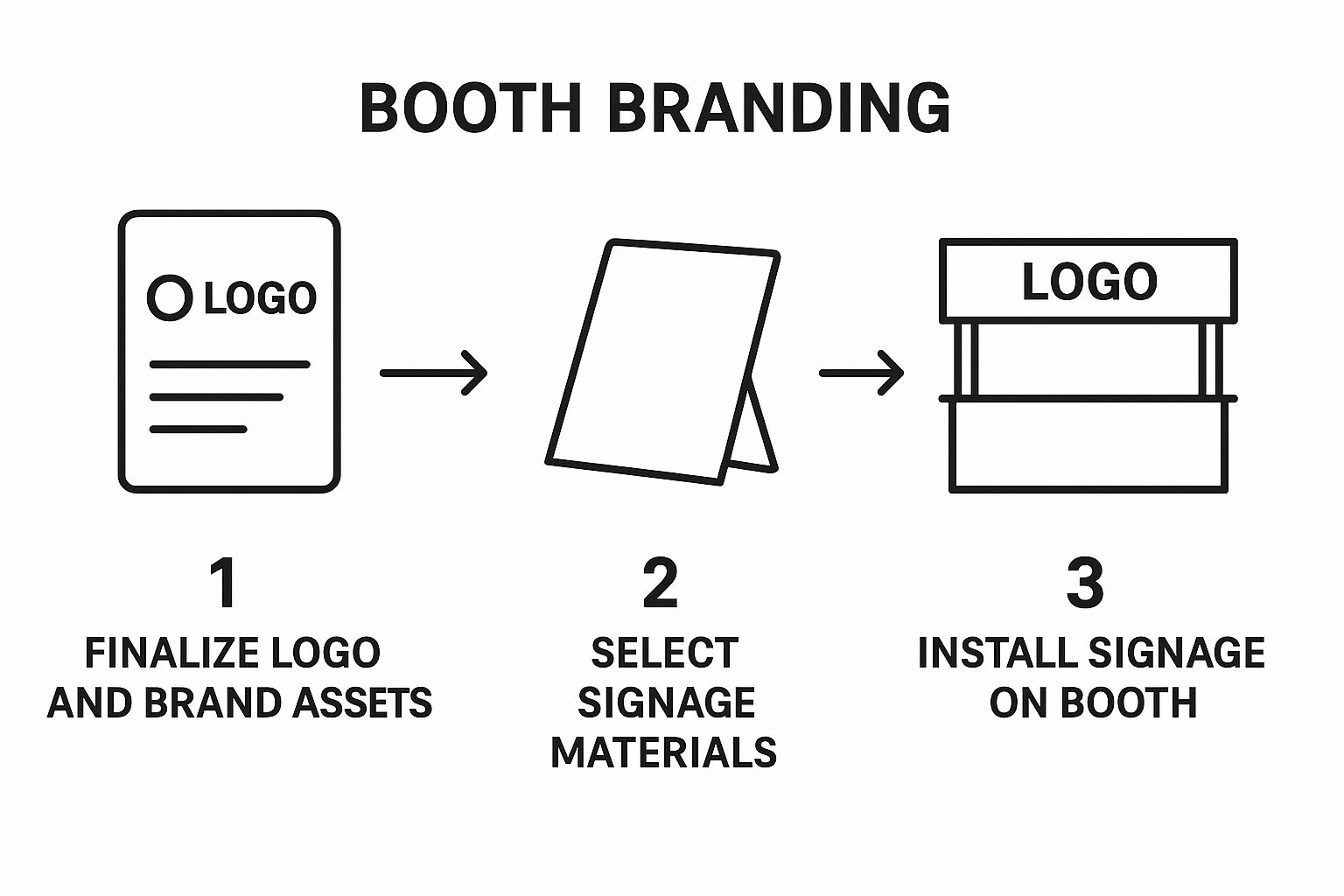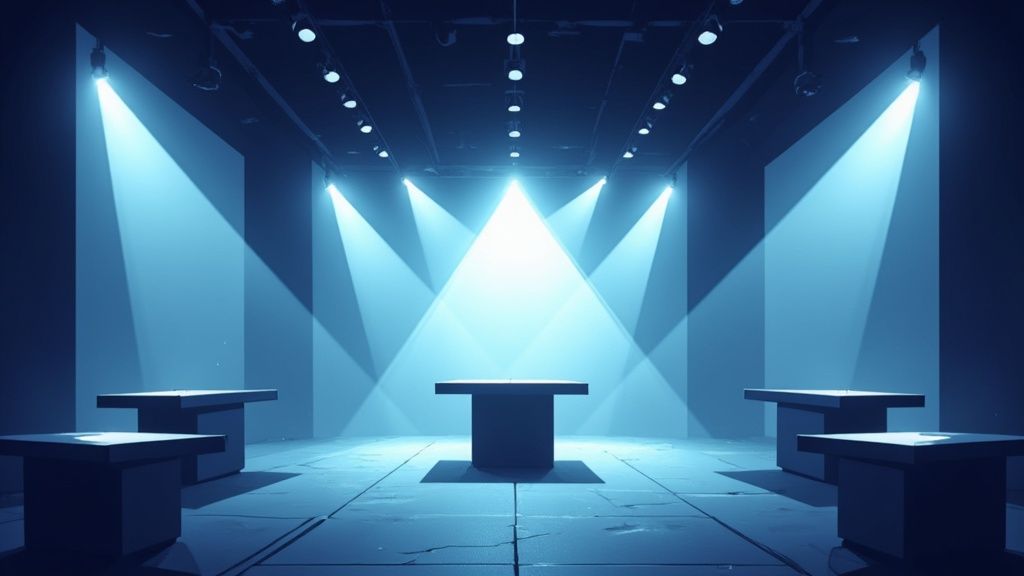Setting Up Booth: Expert Tips for a Standout Display
Learn proven strategies for setting up a booth that attracts sponsors and boosts your conference success. Maximize impact with our expert guide.
A winning conference booth isn't built on the day of the show. It's the result of a deliberate, data-driven process that starts months beforehand. This is where you transform an empty 10x10 space into your biggest sponsorship-generating asset. Success comes down to smart planning: using data to pick the right conference and the right spot, setting sharp goals for sponsorship acquisition, and building a budget that leaves no room for surprises.
From Floor Plan to First Impression

The first moves you make are the most important. This isn't just about booking any space; it's about securing the right space at the right event. Having analyzed thousands of conference layouts and sponsor outcomes, we know the most successful exhibitors begin by obsessing over attendee traffic patterns and historical sponsor data.
Most organizers have data from previous years—ask for it. Hunt for those high-traffic intersections, the prime real estate near the keynote stage, or even spots next to the cafe. You're looking for maximum exposure to your target sponsors. Getting stuck in a forgotten corner is the fastest way to kill your sponsorship ROI.
Defining Your Booth's Core Objectives
Once you've scouted a location within a high-value conference, you need to get crystal clear on what success looks like. A fuzzy goal like "get more sponsors" won't cut it. You need specific, measurable targets directly tied to your sponsorship acquisition strategy.
Think in terms of concrete, data-backed objectives. For instance:
- Lead Generation: Aim to capture 50 qualified sponsor leads. Define "qualified" using data—perhaps a decision-maker from a company that has sponsored similar events in the past.
- Meeting Targets: Your goal could be to schedule 10 high-level meetings right there at the booth with prospects identified through pre-conference data analysis.
- Pipeline Value: A great metric is tracking potential dollar value. A goal might be to add $250,000 in potential sponsorship value to your pipeline within 30 days of the show.
Targets like these turn your booth from a passive display into a focused sponsorship engine. They give your team a scoreboard and make it easy to justify the investment. If you need help finding the right events to hit these kinds of goals, check out this curated list of trade show conferences.
Building a Realistic Budget for Your Booth
One of the most common mistakes we see exhibitors make is underestimating the true cost of a booth. The price you pay for the floor space is just the beginning.
Based on our data, the real cost of a booth is often 3-5 times the price of the physical space. Hidden fees for services like drayage, electricity, and internet can quickly inflate your budget if not planned for.
To avoid getting blindsided, you need to dissect the exhibitor services manual. Your budget spreadsheet should have line items for everything:
- Drayage: The non-negotiable fee for moving your materials from the loading dock to your booth.
- Electrical and Internet: These are rarely included, and you can't run demos or capture leads without them.
- Flooring: Most venues require you to have carpet or another floor covering, which is almost always an extra rental cost.
- Shipping and Logistics: Factor in the round-trip cost of getting your booth and materials to the venue.
- Staffing: This includes flights, hotels, and per diems for every person you bring.
Ultimately, the goal isn't just about the physical setup. Knowing how to maximize your presence at an expo is what creates a lasting impression. This foundational planning—from location analysis and goal setting to a detailed budget—ensures every decision is deliberate and drives you toward your ultimate goal: securing valuable sponsorships.
Designing a Booth That Catches a Sponsor's Eye
Your booth is more than just real estate on a crowded conference floor. It's your primary tool for capturing a sponsor's attention and sparking a conversation. Forget trying to cram every detail about your event or company onto a banner. The goal is to create an experience that pulls decision-makers in and turns casual glances into qualified sponsorship discussions.
The first rule? Open things up. After analyzing thousands of booth designs, we see that the ones getting the most traffic feel spacious and easy to enter. Putting a large table at the front is a classic mistake; it creates a physical and psychological barrier. Instead, push your main displays to the back and sides to create a clear, welcoming path.
This simple layout shift creates a low-pressure zone where a potential sponsor feels comfortable enough to linger, rather than feeling like they're about to be ambushed. Think of it as a friendly handshake, not a hard sell. That small psychological difference can be what kicks off a productive conversation.
Nailing Your Message in Ten Seconds or Less
You have less than ten seconds to grab a potential sponsor's attention. Your messaging must be razor-sharp, concise, and focused entirely on the value you offer them. Messy graphics and long, jargon-filled taglines are the fastest way to be ignored.
Your main back wall graphic needs to answer one question for the sponsor walking by: "What's in it for me?" Stop talking about yourself and start talking about the outcome you deliver for them.
- Instead of: "We Are the Leading Annual Tech Conference"
- Try: "Connect with 10,000 Verified C-Suite Buyers"
The difference is clear: you’ve shifted from who you are to the value you provide. That’s what a sponsor is looking for. The exhibitors who understand this see a huge jump in the quality of their leads. Use big, bold, easy-to-read fonts with high-contrast colors to ensure your message is clear from across the aisle.
Using Light and Tech to Your Advantage
Lighting is one of the most underrated tools in booth design. A well-lit space feels more professional and magnetic. Use spotlights to highlight your main value proposition on the back wall or make a display pop. Bright lighting breathes energy into your space, making it far more inviting.
Technology can also provide a serious edge. A large monitor playing a silent loop of past sponsor testimonials or a tablet loaded with your sponsorship prospectus adds a clean, interactive layer. For a truly memorable experience, you could even explore incorporating augmented reality into your display.
An interactive element is brilliant because it serves two functions: it draws people in with something engaging, and it gives your team a natural way to start a conversation. It bridges the gap between passive viewing and active engagement.
This approach shows you're forward-thinking and committed to a quality presentation—two traits that high-value sponsors notice and respect.
Why Your Materials (and Your Values) Matter
The physical materials you choose signal your brand's quality. Flimsy pop-up banners and wobbly furniture can send an unconscious message that you're not a serious player. It’s worth investing in sturdy, well-made components that can be reused for multiple events.
This ties into a major trend: sustainability. Today, being eco-conscious is a core value for many top-tier companies. In fact, our data indicates that a growing number of exhibitors are taking steps to reduce their environmental impact. Choosing reusable booth components or using eco-friendly materials shows that your values align with modern expectations. It can even become a great talking point with potential partners who share those priorities.
Every choice—from layout and lighting to your core message and materials—must work together. It’s all about creating a professional, welcoming, and value-driven space. This strategic approach to setting up a booth is what transforms a patch of carpet into a machine for attracting and winning high-value sponsorships.
Training Your Team to Talk Sponsorship

Even the most impressive booth is just an empty stage without a sharp team running the show. Your staff aren't just there to scan badges; they are your front-line ambassadors who turn a curious glance into a signed sponsorship agreement. Nailing your booth setup is as much about the people as it is about the design.
The goal is to turn your booth into a hub of productive, sponsor-focused conversations. This means equipping your team with the specific skills to spot, engage, and qualify potential partners on a noisy conference floor.
Building Your A-Team
First, you need the right mix of people. A common mistake is staffing the booth entirely with technical experts. While their knowledge is valuable, they often lack the commercial instincts to pivot a technical question into a discussion about partnership.
Your dream team is a strategic blend of skills:
- The Relationship Builder: This is your natural conversationalist, fantastic at drawing people in and making them feel at ease.
- The Data Expert: This person knows your audience demographics and past sponsor successes inside and out, adding crucial substance to the conversation.
- The Deal Closer: This is usually a senior sales or business development lead. They have the experience to recognize a high-value prospect and guide the conversation toward concrete next steps.
When you have this balance, you're prepared for any conversation, from a high-level chat with a CMO to a detailed query about audience engagement metrics.
Crafting Engaging Opening Questions
Nothing kills a conversation faster than "Can I help you?" Train your staff to use open-ended questions geared toward potential sponsors. The goal is to understand their objectives for being at the conference.
Here are a few examples to role-play with your team:
- "What's been the most valuable session you've attended so far?" (This builds rapport and reveals their interests.)
- "What's the main challenge you're hoping to solve by being here this week?" (This gets right to their pain points.)
- "Are you exploring new ways to reach [Target Audience] in the coming year?" (This positions your conference or platform as a direct solution.)
These questions turn a passive visit into an active discovery process, helping your team quickly qualify potential partners.
The most effective booth teams don't wait for attendees to ask questions. They initiate conversations by asking insightful questions, shifting the dynamic from a sales pitch to a collaborative discussion about mutual goals.
Scheduling for Peak Performance
A tired team is your worst enemy on the conference floor. These days are long and draining. Expecting anyone to be "on" for eight hours straight is unrealistic. You need a smart schedule to keep everyone energized.
A two-on, two-off rotation works well. This ensures you always have fresh, motivated people at the booth while giving others a chance to recharge or walk the floor to research competitor sponsors. This proactive scheduling is a critical, but often missed, part of setting up a booth for success.
Finally, ensure every good conversation is captured properly. Use a lead capture app that allows staff to do more than scan a badge. They need to add detailed notes, qualify the lead's potential based on your pre-defined criteria, and set a next action right then and there. This data is the bridge between a great chat on the floor and a signed contract weeks later.
Bringing It All Together: A Flawless On-Site Execution
After months of planning, conference day is all about execution. A smooth, professional setup isn't just about logistics; it's the first impression you make. It tells potential sponsors that you're organized, competent, and ready for business. Nail this, and your team can focus on what really matters: building relationships.
The Arrival: Your First Hour On-Site
The moment you arrive, head straight for the exhibitor services desk. Come armed with a physical binder containing every single order confirmation—electricity, internet, drayage, and furnishings. When the Wi-Fi is overloaded and you need to prove you paid for premium placement, that binder will be your best friend.
Checking in immediately lets you confirm that everything is on schedule and fix any small discrepancies before they become a crisis. It sets a calm, in-control tone for your setup day.
Coordinating with Venue Staff and Vendors
Think of the on-site crew—the forklift operators, electricians, and riggers—as part of your team for the day. A little patience and a friendly attitude can turn a four-hour wait for a power hookup into a 15-minute fix.
Before a single crate is opened, take a minute to walk your assigned booth space.
- Check the Footprint: Pull out a tape measure and make sure the space you were given matches your contract.
- Locate Utilities: Find your electrical outlets and internet ports. Are they active and where you expected them to be?
- Inspect the Floor: If you ordered special flooring, check that it's the right one and properly installed.
Catching an issue now is a minor inconvenience. Discovering you have no power when you’re trying to mount a monitor is a major headache.
The secret to a smooth on-site execution is anticipating what can go wrong. Always have a "Plan B" kit with essentials like extra power strips, gaffer tape, and a backup for critical graphics. This ability to pivot without panic separates the pros from the rookies.
This detail-oriented preparation sends a powerful, non-verbal signal to anyone walking by: your organization is professional and reliable.
The infographic below breaks down the core stages of bringing your booth's visual identity to life on the conference floor.

As you can see, a polished final look is the result of a logical process, starting with design finalization and culminating in the physical installation of your brand assets.
Managing Inventory and Rallying the Team
Don't just shove boxes of collateral under a draped table. Disorganization looks sloppy and slows you down. Keep a small, organized stash of your most important handouts—like sponsorship prospectuses—within easy reach. The rest should be stored neatly out of sight. For more advanced ideas, check out our guide on effective conference booth storage solutions.
This might seem like a small detail, but it matters. Running out of a key brochure during a traffic surge is an easily avoidable mistake. After all, with some data showing that nearly 33% of new business can be generated at these events, every interaction counts. You can explore more data on the value of booth marketing strategies.
To ensure everything runs like a well-oiled machine, use this simple on-site checklist.
The On-Site Booth Execution Checklist
| Phase | Key Task | Success Metric |
|---|---|---|
| Arrival & Check-In | Confirm all vendor orders at the exhibitor desk. | All services (power, internet, etc.) are confirmed and scheduled. |
| Space Inspection | Verify booth dimensions and utility placement. | Space matches contract; all utilities are active and correctly placed. |
| Unpacking & Assembly | Systematically unpack and assemble the booth structure. | Booth structure is safely and correctly assembled within 3 hours. |
| Tech & AV Setup | Install and test all monitors, tablets, and lighting. | All tech is fully functional and connected to power/internet. |
| Branding & Graphics | Apply all vinyl, hang banners, and set up signage. | All branding elements are correctly placed, damage-free, and visible. |
| Inventory & Collateral | Organize swag and sponsorship materials for easy access. | Key materials are accessible; storage area is neat and organized. |
| Final Walk-Through | Conduct a final team review of the finished booth. | Booth is 100% ready for guests; no outstanding issues. |
| Daily Huddle | Hold a 15-minute pre-show meeting each day. | Team is aligned on daily goals and key sponsor targets. |
| Tear-Down | Efficiently dismantle and pack all booth components. | All items packed correctly, inventory logged, and drayage forms complete. |
This checklist keeps the entire process on track and prevents critical steps from being missed during the chaos of setup and tear-down.
Finally, make daily team huddles non-negotiable. Before the doors open, get everyone together for a 15-minute briefing. Cover the goals for the day, highlight any VIPs or key sponsor prospects you're expecting, and clarify roles. This simple ritual keeps the team aligned, motivated, and ready to turn every conversation into a genuine opportunity.
Turning Booth Conversations Into Contracts

The real ROI of your conference booth isn't tallied when the expo hall lights go out. It’s earned in the days and weeks that follow. An amazing booth gets people to talk, but it’s your data-driven follow-up that turns handshakes into sponsorship contracts.
This is where most exhibitors drop the ball.
The connections you make on the floor are perishable. That great rapport can evaporate in the flood of post-event emails. A generic, one-size-fits-all message is a surefire way to waste a great conversation. The key is to act with speed, precision, and a personal touch.
Segment Your Leads for Maximum Impact
Before drafting an email, you have to segment the leads your team gathered. Not every badge scan is equal. Using the notes your team took, categorize every contact into a simple tier system as soon as the event ends.
- Tier 1 (Hot Leads): These are your top priority. They showed obvious interest, discussed specific partnership ideas, and agreed to a next step. A personalized follow-up must be in their inbox within 24 hours.
- Tier 2 (Warm Leads): These contacts were genuinely interested, but the conversation was more general. They’re strong potential partners who need more nurturing. A follow-up within 48-72 hours is perfect.
- Tier 3 (Cool Leads): This is your catch-all for general inquiries. They shouldn't be ignored, but they don't need immediate one-on-one attention. Add them to a dedicated post-conference nurture sequence.
This tiered approach ensures your team’s energy is focused where it matters most, capitalizing on the momentum with your most promising sponsorship prospects.
Craft a Follow-Up That Actually Re-Engages
Your follow-up email is your chance to pick up where you left off. The goal isn't just to say "nice to meet you"—it's to provide immediate value and remind them why your conversation was worthwhile.
An effective follow-up must be highly personalized. Reference something specific you talked about—a sponsorship package they liked or a challenge they mentioned. This simple act proves you were listening and makes your email stand out.
It also needs a crystal-clear call to action. Don't be vague. Suggest a specific day and time for a quick call to explore the sponsorship ideas you discussed. Make it easy for them to say yes.
The best post-event follow-ups don't feel like a sales pitch. They feel like a natural continuation of the conversation, reinforcing the connection and showing you’re serious about a potential partnership.
This is often the point where organizations realize they need a better system for managing these interactions. If you're building out a more robust strategy, our guide on how to connect with conference sponsors is a great place to start.
Measure What Really Matters
To justify the expense of setting up a booth, you have to track the right metrics. It's time to move beyond vanity metrics like total lead count and measure real business impact.
Your post-conference analysis should focus on these key performance indicators:
- Cost Per Qualified Lead (CPQL): Take your total event cost and divide it by the number of Tier 1 and Tier 2 sponsor leads generated. This tells you exactly how much you're spending to find real potential partners.
- Sponsorship Pipeline Value: Add up the total potential contract value of all the opportunities that came from the event. This shows the future revenue your booth directly influenced.
- Final ROI: This is the ultimate metric. Track the leads from the event all the way through to a signed contract. The total value of sponsorships you closed, measured against the total cost of the event, gives you the definitive measure of success.
The global exhibitions market has massive commercial value, and with forecasts showing continued growth, competition on the conference floor is only getting tougher. You can learn more about the expanding exhibitions market and see why data-driven follow-up is no longer optional. These hard numbers don't just prove your conference strategy is working; they give you the insights to refine your approach and make every future event even more profitable.
Common Questions About Booth Strategy
When you’re deep in exhibit plans, questions always arise. We’ve analyzed data from thousands of events to pinpoint the most common challenges sponsors and exhibitors face.
How Far In Advance Should I Start Planning My Booth Setup
Our data shows that top-performing exhibitors begin planning 9 to 12 months before an event. This timeframe allows them to secure the best booth locations—the high-traffic corners and prime spots near entrances—before they are gone.
Waiting until six months out often means facing rush fees for design and shipping, which can inflate budgets. Early planning not only controls costs but also maximizes your sponsorship potential.
What Are The Most Common Hidden Costs
Your booth fee is just the starting point. Ancillary charges typically add 30-50% to the total cost, often surprising first-time exhibitors.
Key hidden costs to budget for include:
- Drayage Fees: The cost to move your materials from the loading dock to your booth space.
- Electricity & Internet: Ordering these services on-site is significantly more expensive than ordering in advance.
- Mandatory Flooring: Most venues require carpet or other floor coverings, which are rarely included.
Analyze the exhibitor manual as soon as you receive it. Securing an all-inclusive quote early can protect you from expensive last-minute charges.
How Can I Prove The ROI Of My Conference Booth
Proving ROI starts with setting clear, measurable goals, such as securing 20 qualified sponsor meetings or adding a specific dollar amount to your pipeline. Before the event, meticulously track all costs: booth space, travel, staff time, and materials.
During the event, use a digital lead capture system to qualify each prospect based on their sponsorship potential. Afterward, track these leads in your CRM to calculate your Cost Per Qualified Lead (CPQL) and the final value of closed deals. This data provides an ironclad justification for your conference budget.
What Is The Best Way To Attract Sponsors To My Booth
Attracting sponsors begins weeks before the event. Use data to identify high-potential attendees and send personalized invites highlighting an exclusive offer or meeting opportunity at your booth.
On-site, ensure your booth is open and inviting with bright lighting, an uncluttered design, and an interactive element, like a live dashboard of audience data. Train your team to ask open-ended questions that uncover a prospect’s goals, turning a simple visit into a strategic partnership discussion.
At ConferenceDatabase, we provide the critical data you need to make smarter decisions about which conferences to attend and how to maximize your sponsorship ROI. Our platform offers detailed insights on attendee counts, historical sponsor spending, and event quality scores to ensure your investment is directed at the opportunities with the highest potential. Discover your next high-value conference at https://conferencedatabase.com.